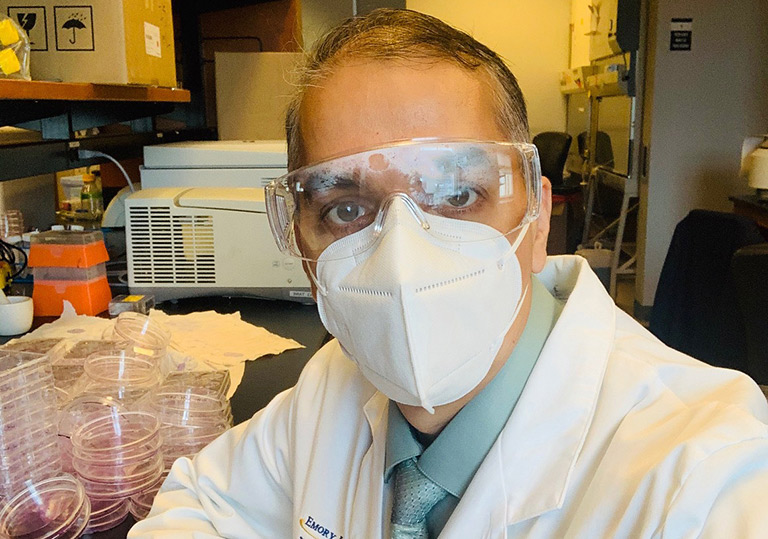Khan’s medical breakthrough sparks hope during COVID-19 crisis

Mohammad Khan, MD, DABR, FACRO
Radiation oncologist Mohammad Khan (NE/PhD, ’02) recalls the mood in March. Everyone—doctors and patients alike—was in shock about COVID-19 which led him to think about radiotherapy in a new way.
“Patients were afraid to come see us and we were afraid to see our patients,” said Khan, an associate professor at Emory University’s School of Medicine. “We also realized there weren’t enough face masks or shields, gloves, and protection for all the doctors taking care of the patients. We were wondering what could we do. I was thinking outside the box because of the circumstances of the pandemic, and the fear probably drove me to think a little differently.”
As a radiation expert, Khan is used to other medical disciplines overlooking radiotherapy treatment for infection. But in the moment of impending crisis, inspiration struck.
The Spark of Innovation Buried in the Past
As Khan was searching for answers, he came across a summary of bacterial pneumonia being treated with radiation in the 1920s and 30s. Although very different than COVID-19, Khan thought that if they did radiotherapy before the antibiotic era, it might work now, too.
He quickly pulled a team together as he wrote the clinical trial. In addition to getting a radiologist, an immunologist, the cancer director, and the departmental leadership involved, he also had to convince doctors outside the department who were skeptics.
“I had to educate them and remind them that there is anecdotal data that talks about radiotherapy helping pneumonia patients,” said Khan. “We didn’t have any other options, so it was easier to convince them that we needed to try something for these patients and could not wait for years until preclinical data are completed.”
The idea started to gain momentum and Khan asked only for a small trial of five patients from the institutional review board (IRB), which looks at the ethics of doing a clinical trial and the hypothesis and background. They concluded the trial could move forward with this small number of patients.
Operationalizing the trial was challenging.
“We had to navigate the logistics of how to treat a COVID-19 patient safely, which required multiple levels of training, and we had to get buy-in from all the surrounding doctors,” said Khan. “We had to convince them that we could do it safely and that our processes were going to be very efficient and follow all the safeguards.” In the end, they streamlined the transportation and treatment to a mere 25 minutes.
On April 24, Khan’s team administered radiotherapy treatment to a COVID-19 patient. By April 28, they had treated all five patients in the cohort. Within seven days, four of the five patients did much better than expected and were coming off oxygen within one-and-a-half days on average. The fifth patient died, but not before his conditions first improved.
IRB then gave the approval to test another five patients, all who improved and were discharged. The ages of the 10 patients ranged from 44 to 104. The trial has now moved to phase 3 for confirmation of the results.
Safer Bedside Manner
Even before the trials began, Khan thought it would be more effective to have a bedside unit safely administer the radiotherapy to eliminate the possibility of unnecessary SARS-CoV-2 exposure.
Khan reached out to his alma mater for help. Nuclear Engineering Department Head Wes Hines saw the importance and quickly pulled in Associate Professor Eric Lukosi, John D. Tickle Professor Lawrence Heilbronn, and researchers at ORNL.
“I was skeptical when Mohammad called me; however, he quickly explained the theory and we were thrilled to be asked to participate in what could be the greatest medical breakthrough during the worst medical pandemic in modern times,” said Hines.
The team was tasked with rapidly developing a prototype and identifying a commercially available X-ray source of sufficient emission energy and intensity to treat a patient.
“The ancillary design is equally important to minimize unwanted radiation doses to other parts of the body, the technician, and to adjacent rooms,” noted Lukosi.
A mobile radiotherapy device could not only change the statistics of a global pandemic, but it could potentially help any high-risk patient suffering from advanced stages of pneumonia and could be useful for other purposes in the future.
“The opportunity to collaborate with outstanding team members and make a direct impact on people’s lives is very exciting and rewarding,” Heilbronn said.
The team is working as quickly and safely as possible, but getting a product to market will also include getting approval for use as a medical device, which is a yet-unknown process. They hope to have a prototype ready for field testing by the end of 2020.
Contact
Élan Young: elan@tennessee.edu